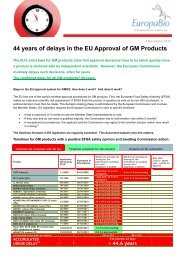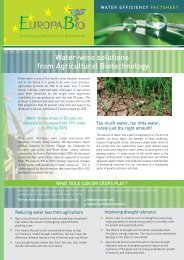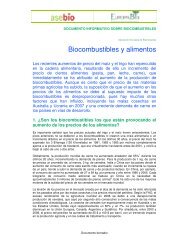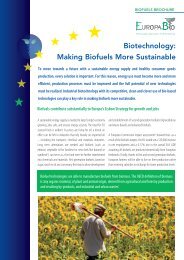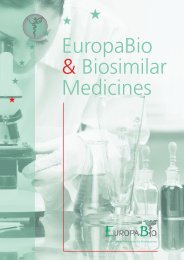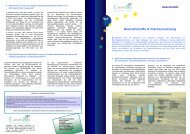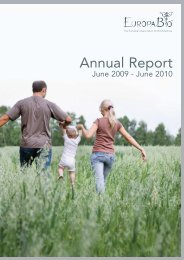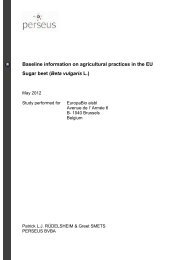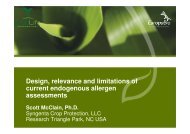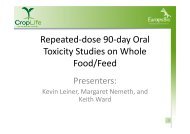GM crops: Reaping the benefits, but not in Europe - Europabio
GM crops: Reaping the benefits, but not in Europe - Europabio
GM crops: Reaping the benefits, but not in Europe - Europabio
Create successful ePaper yourself
Turn your PDF publications into a flip-book with our unique Google optimized e-Paper software.
<strong>GM</strong> <strong>crops</strong>:<br />
<strong>Reap<strong>in</strong>g</strong> <strong>the</strong> <strong>benefits</strong>,<br />
<strong>but</strong> <strong>not</strong> <strong>in</strong> <strong>Europe</strong><br />
Socio-economic impacts of agricultural biotechnology
TABLE OF CONTENTS<br />
1. INTRODUCTION 3<br />
2. GLOBAL IMPACTS AT FARM LEVEL 4<br />
3. GLOBAL MACRO ECONOMIC IMPACTS 6<br />
4. GLOBAL IMPACTS ON THE ENVIRONMENT 8<br />
5. EU IMPACTS FROM TWO AVAILABLE PRODUCTS 10<br />
6. LOST ECONOMIC OPPORTUNITIES IN THE EU 12<br />
7. IMPORTS, <strong>GM</strong> TRACES AND IMPACTS ON THE EUROPEAN CHAIN 14<br />
8. REGULATORY COSTS 18<br />
9. CONCLUSIONS 18<br />
10. SOURCES 19<br />
About this report<br />
This report has first been published <strong>in</strong> May 2011. The present is <strong>the</strong> 2 nd edition from August 2011.<br />
It provides a comprehensive overview of <strong>the</strong> socio-economic impacts of <strong>the</strong> cultivation<br />
and trade of genetically modified (<strong>GM</strong>) <strong>crops</strong>, based on <strong>the</strong> latest available scientific publications.<br />
First a global overview is provided. The socio-economic impacts of <strong>GM</strong> cultivation <strong>in</strong> <strong>Europe</strong> are<br />
explored <strong>in</strong> <strong>the</strong> next part which takes <strong>in</strong>to account both observed <strong>benefits</strong> (ex post analysis) as well<br />
as lost opportunities (ex ante analysis). F<strong>in</strong>ally, trade and regulatory impacts on <strong>Europe</strong> are analysed<br />
<strong>in</strong> <strong>the</strong> last section.
1. INTRODUCTION<br />
Biotech <strong>crops</strong> grow<strong>in</strong>g around <strong>the</strong> world<br />
S<strong>in</strong>ce <strong>the</strong> first commercialisation of genetically modified <strong>crops</strong> <strong>in</strong> 1996, agricultural biotechnology has<br />
spread rapidly around <strong>the</strong> world. In 2010, 15.4 million farmers <strong>in</strong> 29 countries cultivated <strong>GM</strong> <strong>crops</strong> and<br />
experienced socio-economic and environmental <strong>benefits</strong>.<br />
Address<strong>in</strong>g <strong>benefits</strong> and concerns<br />
The reasons for farmers to choose biotech <strong>crops</strong> <strong>in</strong>clude higher productivity, such as yield <strong>in</strong>creases<br />
of up to 30% on <strong>the</strong> same amount of land, and extra <strong>in</strong>come. Significant environmental <strong>benefits</strong> have<br />
also been recorded, such as reduced pesticide application and reduced CO 2 emissions, and decreased<br />
soil erosion through <strong>the</strong> adoption of no-till practices. However, especially <strong>in</strong> <strong>Europe</strong> people still have<br />
concerns about <strong>the</strong> impact of <strong>GM</strong> <strong>crops</strong>. Apart from ethical, environmental and safety issues, some<br />
people raise socio-economic impacts, like access of <strong>the</strong> technology for poor farmers or questions<br />
about who really <strong>benefits</strong>.<br />
REGULATING SOCIO-ECONOMICS?<br />
The importance of tak<strong>in</strong>g <strong>the</strong> socio-economic impacts of <strong>GM</strong>Os <strong>in</strong>to account has been highlighted by<br />
various groups and risk managers. As part of <strong>the</strong> December 2008 Environment Council conclusions,<br />
<strong>the</strong> <strong>Europe</strong>an Commission was asked to compile Member States’ considerations on this issue.<br />
The Commission report was published <strong>in</strong> April 2011.<br />
Concern<strong>in</strong>g regulation, it should be <strong>not</strong>ed that, <strong>in</strong> modern market economies, economic impacts are<br />
<strong>not</strong> usually reasons to restrict products, s<strong>in</strong>ce any economic risk is borne by economic actors. In any<br />
market, only economically viable products are successful.<br />
The Commission confirmed this when it said that “socio-economic factors can<strong>not</strong> be taken <strong>in</strong>to<br />
account when approv<strong>in</strong>g <strong>GM</strong> <strong>crops</strong>. To be approved, <strong>the</strong>y must simply be shown to be safe for human<br />
health and <strong>the</strong> environment”. 1<br />
3
4<br />
2. GLOBAL IMPACTS AT FARM LEVEL<br />
CAN 15 MILLION FARMERS BE WRONG?<br />
“You’re <strong>not</strong> go<strong>in</strong>g to spend money on a specific seed unless it has real <strong>benefits</strong>.”<br />
Paul Temple, UK farmer (2 March 2011, Brussels)<br />
In countries where farmers are allowed to grow <strong>GM</strong> <strong>crops</strong>, <strong>the</strong>y <strong>in</strong>creas<strong>in</strong>gly choose to do so. In 2010,<br />
15.4 million farmers <strong>in</strong> 29 countries cultivated <strong>GM</strong> <strong>crops</strong> 2 . This is more than twice <strong>the</strong> number of farms<br />
<strong>in</strong> <strong>the</strong> EU. Most of <strong>the</strong>se farmers stick to <strong>the</strong> technology once <strong>the</strong>y have tried it <strong>the</strong>mselves. 93% of<br />
Spanish farmers who grew <strong>GM</strong> maize <strong>in</strong> 2010 said <strong>the</strong>y would do aga<strong>in</strong> <strong>in</strong> 2011. In 2010, <strong>GM</strong> <strong>crops</strong> were<br />
cultivated on 148 million hectares worldwide, which is roughly equivalent to <strong>the</strong> comb<strong>in</strong>ed landmasses<br />
of France, Spa<strong>in</strong> and Germany. It is more than <strong>the</strong> entire area of arable land <strong>in</strong> <strong>the</strong> EU 3 .<br />
Global cultivation of <strong>GM</strong> <strong>crops</strong> – by crop<br />
million ha.<br />
160<br />
140<br />
120<br />
100<br />
80<br />
60<br />
40<br />
20<br />
0<br />
1996<br />
1997<br />
1998<br />
1999<br />
2000<br />
2001<br />
2002<br />
SOYA MAIZE<br />
COTTON<br />
RAPESEED<br />
Boost<strong>in</strong>g farm <strong>in</strong>come and production<br />
2003<br />
2004<br />
2005<br />
“Biotech <strong>crops</strong> can <strong>in</strong>crease productivity and (farmer) <strong>in</strong>come significantly, and hence, can serve as an<br />
eng<strong>in</strong>e of rural economic growth that can contri<strong>but</strong>e to <strong>the</strong> alleviation of poverty for <strong>the</strong> world’s small<br />
and resource-poor farmers.” 4<br />
Independent research <strong>in</strong>to <strong>the</strong> economic impacts of <strong>GM</strong> cultivation demonstrates clear <strong>benefits</strong>.<br />
The net global economic <strong>benefits</strong> at <strong>the</strong> farm level added by cultivat<strong>in</strong>g <strong>GM</strong> ra<strong>the</strong>r than conventional<br />
varieties have been estimated at $10.8 billion <strong>in</strong> 2009 – <strong>the</strong> equivalent of add<strong>in</strong>g 5.8% to <strong>the</strong> value<br />
of global production of <strong>the</strong> four ma<strong>in</strong> <strong>crops</strong> of soya beans, maize, cotton and rapeseed. Comb<strong>in</strong>ed<br />
<strong>benefits</strong> for a 14-year period (1996 to 2009) have been calculated at $64.7 billion 5 .<br />
<strong>GM</strong> <strong>crops</strong> have also made important contri<strong>but</strong>ions to <strong>in</strong>creas<strong>in</strong>g global production levels of <strong>the</strong> four<br />
ma<strong>in</strong> <strong>crops</strong>. To achieve <strong>the</strong> same level of production without <strong>the</strong> use of <strong>GM</strong>Os <strong>in</strong> 2009, an additional<br />
total area of 12.4 million hectares – equivalent to nearly <strong>the</strong> entire surface of England – would have<br />
been needed (<strong>in</strong>clud<strong>in</strong>g 5.6 million ha for maize and 3.8 million ha for soya beans) 5 . The enormous<br />
uptake <strong>in</strong> <strong>GM</strong> crop cultivation can only be expla<strong>in</strong>ed by <strong>the</strong> real and genu<strong>in</strong>e advantages that <strong>the</strong>se<br />
<strong>crops</strong> offer farmers.<br />
2006<br />
2007<br />
2008<br />
2009<br />
2010<br />
Source<br />
ISAAA
Average global <strong>in</strong>come ga<strong>in</strong>s ($/ha) for 1996-2009 period for <strong>the</strong> four ma<strong>in</strong> <strong>crops</strong> 6<br />
SOYA BEAN MAIZE COTTON RAPESEED<br />
42 22 26 39<br />
Global cultivation of <strong>GM</strong> <strong>crops</strong> – by country<br />
Global acreage with genetically modified <strong>crops</strong> by country, 1996-2010<br />
million ha.<br />
160<br />
140<br />
120<br />
100<br />
80<br />
60<br />
40<br />
20<br />
0<br />
1996<br />
1997<br />
1998<br />
Small farmers benefit too<br />
Some say that only big farmers benefit from <strong>GM</strong> <strong>crops</strong>. Yet over 90%, or 14.4 million, of <strong>the</strong> farmers<br />
who grew <strong>GM</strong> <strong>crops</strong> <strong>in</strong> 2010 were small, resource-poor farmers <strong>in</strong> develop<strong>in</strong>g countries 7 . Farm size has<br />
<strong>not</strong> been a factor affect<strong>in</strong>g <strong>the</strong>ir choice 8 .<br />
FAST FACTS<br />
1999<br />
2000<br />
<strong>GM</strong>O cultivation worldwide and <strong>in</strong> <strong>the</strong> EU (2010) 9<br />
2001<br />
2002<br />
2003<br />
USA BRASIL<br />
ARGENTINA INDIA CANADA<br />
CHINA PARAGUAY<br />
PAKISTAN<br />
2004<br />
2005<br />
World EU<br />
Number of farmers cultivat<strong>in</strong>g <strong>GM</strong> 15.4 million (under) 6000<br />
Number of countries with <strong>GM</strong> cultivation 29 8<br />
Surface of <strong>GM</strong> fields 148 m ha 0.091 m ha<br />
Change <strong>in</strong> surface of <strong>GM</strong> from 2009 to 2010 Up 10 % Down 3.5 %<br />
Total arable land 1.500 m ha 102 m ha<br />
2006<br />
2007<br />
SOUTH AFRICA<br />
2008<br />
2009<br />
2010<br />
OTHERS<br />
Source<br />
ISAAA<br />
5
6<br />
3. GLOBAL MACRO ECONOMIC IMPACTS<br />
“Benefits from grow<strong>in</strong>g <strong>GM</strong> <strong>crops</strong> ma<strong>in</strong>ly derive from <strong>in</strong>creased yields, which are greatest for small<br />
farmers <strong>in</strong> develop<strong>in</strong>g countries. Apart from higher yields, <strong>the</strong> adoption of <strong>GM</strong> <strong>crops</strong> can reduce<br />
production costs by reduc<strong>in</strong>g pesticide use, labour and fuel costs.” 10<br />
Increas<strong>in</strong>g food security<br />
Higher productivity rates translate <strong>in</strong>to higher food security <strong>in</strong> a world with cont<strong>in</strong>u<strong>in</strong>g population<br />
growth and limited arable land. The additional production aris<strong>in</strong>g from <strong>GM</strong> <strong>crops</strong> between 1996 and<br />
2007 has contri<strong>but</strong>ed enough energy (<strong>in</strong> kcal terms) to feed about 402 million people for one year,<br />
with additional production <strong>in</strong> 2007 alone contri<strong>but</strong><strong>in</strong>g enough energy to feed 88 million 11 .<br />
Support<strong>in</strong>g development<br />
The share of <strong>the</strong> farm <strong>in</strong>come ga<strong>in</strong>s, both <strong>in</strong> 2009 and cumulatively (1996-2009), has been about<br />
50% each for farmers <strong>in</strong> develop<strong>in</strong>g and developed countries 12 . The additional <strong>in</strong>come derived from<br />
<strong>GM</strong> <strong>crops</strong> can enable more farmers to consistently meet <strong>the</strong>ir subsistence needs and to improve<br />
<strong>the</strong> standard of liv<strong>in</strong>g of <strong>the</strong>ir households. Be<strong>in</strong>g able to afford more goods and services can have<br />
a positive ‘knock on’ effect on local, regional and national economies.<br />
Commodity prices and distri<strong>but</strong>ion of <strong>benefits</strong><br />
World prices of maize, soya beans and rapeseed would probably be respectively +5.8%, +9.6%, and<br />
+3.8% higher than current levels if <strong>the</strong>re were no <strong>GM</strong> <strong>crops</strong> 13 . Most <strong>GM</strong> <strong>crops</strong> go <strong>in</strong>to feed, result<strong>in</strong>g also<br />
<strong>in</strong> consumer <strong>benefits</strong> from lower prices for meat. In <strong>Europe</strong> as <strong>in</strong> <strong>the</strong> rest of <strong>the</strong> world – two thirds of<br />
<strong>the</strong> <strong>benefits</strong> of grow<strong>in</strong>g <strong>GM</strong> are shared among <strong>Europe</strong>an farmers and consumers, while on third goes<br />
to <strong>the</strong> gene developers and seed suppliers 14 .
Patents and Royalties<br />
Biotech companies <strong>in</strong>vest very large sums <strong>in</strong> <strong>the</strong> development of <strong>the</strong> most useful new varieties.<br />
Just as with o<strong>the</strong>r technologies, this research is economically viable because <strong>the</strong> <strong>in</strong>ventions can be<br />
patented. Farmers have <strong>the</strong> choice between high performance <strong>GM</strong> seeds that can be more expensive<br />
than conventional seeds because royalties are built <strong>in</strong>to <strong>the</strong> price, or cheaper conventional seeds.<br />
Their choice will depend on <strong>the</strong>ir expected <strong>in</strong>dividual <strong>benefits</strong>.<br />
Royalties as a cost component of transgenic <strong>crops</strong><br />
Cost comparison - Conventional & Biotech Soy (Brasil)<br />
This graph shows why farmers <strong>in</strong> Brazil tend to choose biotech soy. Despite higher seed prices due to<br />
royalties, <strong>the</strong>y eventually save $ 48.80 per hectare, ma<strong>in</strong>ly due to reduced herbicide <strong>in</strong>put.<br />
US$ per hectare<br />
350<br />
300<br />
250<br />
200<br />
150<br />
100<br />
50<br />
0<br />
Market concentration?<br />
US$ 48,80<br />
ROYALTY<br />
Conventional Transgenic<br />
SEEDS HERBICIDES<br />
MACHINE<br />
OPERATION<br />
OTHERS<br />
Source<br />
Conab/Abrasem/Celeres/<br />
ISAAA/Kleffmann<br />
Many <strong>GM</strong> seeds are be<strong>in</strong>g developed by mult<strong>in</strong>ational companies, though <strong>the</strong>re is extensive ongo<strong>in</strong>g<br />
research by SMEs and public universities. High R&D and regulatory costs and lead times constitute<br />
immense market entry barriers for smaller companies. A new advisory report to <strong>the</strong> Dutch government<br />
states that <strong>the</strong>re are no <strong>in</strong>dications whatsoever that market concentration is somehow <strong>in</strong>herent to <strong>GM</strong><br />
technology 15 .<br />
In India, <strong>the</strong> <strong>in</strong>troduction and widespread adoption of two Bt-cotton traits developed by mult<strong>in</strong>ational<br />
companies has opened <strong>the</strong> way to four Bt-cotton traits developed by Indian or Ch<strong>in</strong>ese companies. 16<br />
7
8<br />
4. GLOBAL IMPACTS ON THE ENVIRONMENT<br />
Less land use and better resource efficiency<br />
Increas<strong>in</strong>g yields by 6% - 30% on <strong>the</strong> same amount of land avoids <strong>the</strong> need to cultivate land that<br />
currently provides a haven for biodiversity or is used for conservation. <strong>GM</strong> <strong>crops</strong> with improved<br />
nitrogen-use efficiency need less fertiliser <strong>in</strong>put. Less spray<strong>in</strong>g and less need for fertiliser also means<br />
reductions <strong>in</strong> <strong>the</strong> use of tractor fuel and water. Soils are better protected from erosion and compaction<br />
through less plough<strong>in</strong>g, which helps conserve soil moisture. Field trials demonstrate that droughttolerant<br />
<strong>crops</strong> can yield up to 20% more than <strong>the</strong>ir non-<strong>GM</strong> counterparts under <strong>the</strong> same grow<strong>in</strong>g<br />
conditions, enabl<strong>in</strong>g farmers to grow more while us<strong>in</strong>g less water.<br />
Reduced CO 2 emissions<br />
Less tillage or plough<strong>in</strong>g also helps to reduce CO 2 emissions. In 2009, <strong>the</strong> comb<strong>in</strong>ed permanent and<br />
additional sav<strong>in</strong>gs through sequestration due to <strong>the</strong> cultivation of <strong>GM</strong> <strong>crops</strong> was equivalent to a sav<strong>in</strong>g<br />
of 17.6 billion kg of CO 2 or remov<strong>in</strong>g 7.8 million cars from <strong>the</strong> road for one year 17 . By enabl<strong>in</strong>g farmers<br />
to grow more food, more reliably, <strong>in</strong> less predictable and harsher climatic conditions, <strong>GM</strong> <strong>crops</strong> can<br />
also contri<strong>but</strong>e to climate change adaptation.<br />
Less use of plant protection products<br />
More efficient protection aga<strong>in</strong>st <strong>in</strong>sect damage results <strong>in</strong> a significant reduction <strong>in</strong> <strong>the</strong> need to<br />
spray <strong>crops</strong>. By 2009, <strong>the</strong> usage of <strong>GM</strong> <strong>crops</strong> had reduced pesticide spray<strong>in</strong>g by 393 million kg of<br />
active <strong>in</strong>gredients, <strong>the</strong> equivalent of decreas<strong>in</strong>g 17.1% of <strong>the</strong> global pesticide use 18 . There is a clear<br />
decrease <strong>in</strong> <strong>the</strong> amounts of plant protection products applied to <strong>GM</strong> <strong>crops</strong> 19 , <strong>in</strong>clud<strong>in</strong>g a substantial<br />
25-33% decrease <strong>in</strong> <strong>the</strong> use of agrochemicals for herbicide resistant <strong>crops</strong> 20 . While herbicide resistant<br />
weed populations may emerge, this is <strong>not</strong> a challenge specific to <strong>GM</strong> plants <strong>but</strong> applies equally for<br />
conventional agriculture. The adoption of herbicide tolerant plants led to a reduction <strong>in</strong> <strong>the</strong> toxicity of<br />
<strong>the</strong> herbicides used, and to a wider take up of no till farm<strong>in</strong>g, <strong>the</strong>reby limit<strong>in</strong>g soil erosion, fuel use and<br />
CO 2 emissions.<br />
Protect<strong>in</strong>g biodiversity<br />
Land use is probably <strong>the</strong> most important impact of agriculture on biodiversity. In general, biodiversity<br />
<strong>in</strong> fields is much lower than <strong>in</strong> untouched natural surround<strong>in</strong>gs. This is <strong>in</strong>herent to <strong>the</strong> purpose of<br />
grow<strong>in</strong>g a certa<strong>in</strong> type of crop and avoid<strong>in</strong>g <strong>the</strong> presence of too many o<strong>the</strong>r organisms, such as weeds<br />
and pests, on <strong>the</strong> same field. The high performance of <strong>GM</strong> <strong>crops</strong> allows for <strong>in</strong>tensive farm<strong>in</strong>g, mean<strong>in</strong>g<br />
less land needs to grow <strong>the</strong> same amount of <strong>crops</strong>. Biodiversity on and around fields is a question of<br />
agricultural practices, <strong>not</strong> of crop technology. Numerous studies have demonstrated that <strong>GM</strong> <strong>crops</strong><br />
have no adverse effects on non-target <strong>in</strong>sects 21 . The reduction <strong>in</strong> crop biodiversity is l<strong>in</strong>ked to crop<br />
improvements <strong>in</strong> general, and <strong>not</strong> specifically to <strong>GM</strong> technology.
Almost all of today’s agricultural <strong>crops</strong> and animals have been changed substantially <strong>in</strong> <strong>the</strong> history of<br />
mank<strong>in</strong>d and have largely replaced <strong>the</strong>ir pre-agricultural ancestors. A recent literature review f<strong>in</strong>ds<br />
that, overall,<br />
“currently commercialised <strong>GM</strong> <strong>crops</strong> have reduced <strong>the</strong> impacts of agriculture on biodiversity, through<br />
enhanced adoption of conservation tillage practices, reduction of <strong>in</strong>secticide use and use of more<br />
environmentally benign herbicides and <strong>in</strong>creas<strong>in</strong>g yields to alleviate pressure to convert additional land<br />
<strong>in</strong>to agricultural use”. 22<br />
FAST FACTS<br />
EU research about <strong>GM</strong>O safety for health & <strong>the</strong> environment 23<br />
- Every <strong>GM</strong>O application <strong>in</strong>dependently assessed by EFSA<br />
- ¤300 million EU fund<strong>in</strong>g for research <strong>in</strong>to safety of <strong>GM</strong>Os over 25 years,<br />
over 500 <strong>in</strong>dependent research groups<br />
No identified risk to human health or <strong>the</strong> environment.<br />
9
10<br />
5. EU IMPACTS FROM TWO AVAILABLE PRODUCTS<br />
Two products approved for cultivation<br />
<strong>GM</strong> <strong>crops</strong> can only be cultivated <strong>in</strong> <strong>Europe</strong> when <strong>the</strong>y receive approval. To date, only two <strong>GM</strong> crop<br />
types have been approved for cultivation <strong>in</strong> <strong>the</strong> EU: <strong>in</strong>sect-resistant maize and, s<strong>in</strong>ce 2010, a potato<br />
for <strong>in</strong>dustrial use.<br />
Agricultural Biotechnology <strong>in</strong> <strong>Europe</strong> Plant<strong>in</strong>g figures (<strong>in</strong> ha)<br />
Country vs. Year 2006 2008 2010<br />
Spa<strong>in</strong> 53.667 79.269 76.575<br />
Portugal 1.250 4.851 4.868<br />
Czech Republic 1.290 8.380 4.830<br />
Poland 100 3.000 3.000<br />
Slovakia 300 1.900 1.248<br />
Romania 90.000 9.000 822<br />
Sweden 0 0 80<br />
Germany 950 3.173 15<br />
France 5000 0 0<br />
Total 152.557 109.573 91.438<br />
Note: The strong decreases <strong>in</strong> France and Germany can be expla<strong>in</strong>ed by political bans on MON810 maize.<br />
Romania had to stop cultivation of <strong>GM</strong> soya bean when <strong>the</strong>y jo<strong>in</strong>ed <strong>the</strong> EU <strong>in</strong> January 2007.<br />
Bt maize and <strong>the</strong> corn borer<br />
For years, <strong>in</strong>sect resistant <strong>GM</strong> maize was <strong>the</strong> only <strong>GM</strong> crop cultivated <strong>in</strong> <strong>Europe</strong>. In 2010, it was<br />
cultivated on 91,193 ha, represent<strong>in</strong>g over 99% of <strong>the</strong> land used for <strong>GM</strong> crop cultivation <strong>in</strong> <strong>the</strong> EU.<br />
This is <strong>the</strong> so-called Bt maize – a variant of maize which has been genetically altered to express<br />
a prote<strong>in</strong> from <strong>the</strong> bacterium Bacillus thur<strong>in</strong>giensis. The Bt prote<strong>in</strong> tackles <strong>the</strong> <strong>Europe</strong>an corn borer,<br />
a widespread <strong>in</strong>sect pest present <strong>in</strong> sou<strong>the</strong>rn and middle <strong>Europe</strong>. The corn borer is capable of<br />
destroy<strong>in</strong>g up to 20% of a maize crop 24 .<br />
The Spanish Bt maize experience<br />
Spa<strong>in</strong> is <strong>the</strong> country with by far <strong>the</strong> largest <strong>GM</strong> cultivation <strong>in</strong> <strong>the</strong> EU, all of it be<strong>in</strong>g Bt maize. Additional<br />
farm <strong>in</strong>come s<strong>in</strong>ce <strong>in</strong>troduction of <strong>the</strong> technology <strong>in</strong> Spa<strong>in</strong> has been calculated at $93.5 million 25 .<br />
Average additional earn<strong>in</strong>gs <strong>in</strong> Spa<strong>in</strong> were ¤186/ha 26 . The average yield <strong>in</strong>crease is 6.3% and depends<br />
heavily on <strong>the</strong> <strong>in</strong>tensity of pest <strong>in</strong>festation (with low <strong>in</strong>festation, yield <strong>in</strong>creases of up to 1%, with high<br />
<strong>in</strong>festation, yield <strong>in</strong>creases of 10 to 20% have been reported) 27 .<br />
In a recent survey, 93% of Spanish farmers who planted Bt maize <strong>in</strong> 2010 said <strong>the</strong>y would do so <strong>in</strong> <strong>the</strong><br />
next season 28 . In Spa<strong>in</strong>, <strong>GM</strong> adoption is <strong>not</strong> statistically related to farm size 29 and <strong>the</strong>re was no impact on<br />
<strong>the</strong> amount of farm labour employed. Yield ga<strong>in</strong>s on Bt maize translated directly <strong>in</strong>to revenues <strong>in</strong>crease,<br />
as <strong>the</strong>re is no difference <strong>in</strong> <strong>the</strong> crop price paid to Bt or conventional maize farmers 30 . The economic<br />
welfare result<strong>in</strong>g from adoption of Bt maize <strong>in</strong> Spa<strong>in</strong> is shared between farmers and seed companies,<br />
<strong>in</strong>clud<strong>in</strong>g <strong>the</strong> seed developer, seed producers and seed distri<strong>but</strong>ors. The largest share of welfare<br />
(74.4% on average) went to Bt maize farmers and <strong>the</strong> rest to <strong>the</strong> seed companies (25.6% on average) 31 .<br />
Source<br />
ISAAA
Bt maize and <strong>in</strong>secticides<br />
A significant decrease <strong>in</strong> <strong>in</strong>secticide use was<br />
also demonstrated: fewer farmers applied<br />
<strong>in</strong>secticides on Bt maize (30% compared to<br />
58% of conventional maize farmers) and those<br />
who sprayed did so much less frequently<br />
(0.32 treatments per year compared to<br />
0.86 treatments by conventional maize farmers) 32 .<br />
Impacts on non <strong>GM</strong> farmers, co-existence<br />
Co-existence means that neighbour<strong>in</strong>g farms, or perhaps even <strong>the</strong> same farm, grow both <strong>GM</strong> and<br />
non-<strong>GM</strong> <strong>crops</strong>. It is <strong>not</strong> a new concept, however. For decades, conventional agriculture has successfully<br />
co-existed with organic agriculture, and experience with co-existence between <strong>GM</strong> and non-<strong>GM</strong><br />
agriculture shows that co-existence works. The <strong>Europe</strong>an Commission has stated <strong>the</strong>re have been<br />
no reports of any economic damages aris<strong>in</strong>g from difficulties with co-existence 33 . The Commission<br />
also published a new recommendation on guidel<strong>in</strong>es for <strong>the</strong> development of national co-existence<br />
measures <strong>in</strong> 2010. For <strong>the</strong> rare cases where liability issues do ensue, national liability laws are<br />
applicable. S<strong>in</strong>ce only <strong>GM</strong> <strong>crops</strong> that have passed a rigorous authorisation procedure can be cultivated<br />
<strong>in</strong> <strong>the</strong> EU, coexistence measures do <strong>not</strong> concern environmental or health risks.<br />
FAST FACTS<br />
Bt maize <strong>in</strong> <strong>Europe</strong>:<br />
- 91,193 ha of Bt maize <strong>in</strong> EU (2010)<br />
- 6.3% extra crop yields on average<br />
- Up to 20% extra crop yields when high level of corn borer <strong>in</strong>festation<br />
- 12% to 21% more profits<br />
- 186 ¤/ha extra <strong>in</strong>come (EU average, 2007)<br />
- ¤20.6 million overall direct <strong>in</strong>crease <strong>in</strong> farm <strong>in</strong>comes EU-wide (2007)<br />
- 2.25 to 4 million hectares of maize affected by corn borer<br />
The Amflora Potato<br />
Amflora is a genetically improved potato developed to produce a specific natural starch (amylopect<strong>in</strong>)<br />
tailored for <strong>in</strong>dustrial applications, such as paper, textiles and adhesives. <strong>Europe</strong> produces around<br />
two million metric tons of potato starch every year. The potato starch <strong>in</strong>dustry provides direct <strong>in</strong>come<br />
to over 14,000 farmers and f<strong>in</strong>ancially supports more than 4,000 employees’ families. Factories are<br />
located <strong>in</strong> rural areas and play an important socio-economic role <strong>in</strong> <strong>the</strong>ir regions. Approved <strong>in</strong> 2010,<br />
Amflora was grown on 450 hectares <strong>in</strong> three countries for seed multiplication and <strong>in</strong>itial commercial<br />
production. The ma<strong>in</strong> <strong>benefits</strong> of Amflora are that it:<br />
Source<br />
<strong>Europabio</strong><br />
- creates additional value for <strong>the</strong> starch potato farmers <strong>in</strong> <strong>Europe</strong>;<br />
- reduces production costs;<br />
- is a natural renewable resource;<br />
- reduces <strong>the</strong> use of oil-based chemicals, energy and water.<br />
Maize affected by corn borer<br />
11
12<br />
6. LOST ECONOMIC OPPORTUNITIES IN THE EU<br />
A (<strong>Europe</strong>an) technology denied to most <strong>Europe</strong>ans<br />
In <strong>the</strong> second half of <strong>the</strong> 1980s, Van Montagu and Schell were <strong>the</strong> first to develop and test genetically<br />
eng<strong>in</strong>eered plants at <strong>the</strong> University of Ghent <strong>in</strong> Belgium. In 2010, cultivation <strong>in</strong> <strong>the</strong> EU was limited to<br />
two approved events, cultivated on 91,643 hectares <strong>in</strong> eight Member States. A large number of <strong>GM</strong><br />
<strong>crops</strong> have been wait<strong>in</strong>g for years for EU approval. Worse still for <strong>Europe</strong>an farmers, <strong>GM</strong> cultivation of<br />
certa<strong>in</strong> <strong>crops</strong> has been banned, though <strong>the</strong> bans are legally questionable, <strong>in</strong> Austria, Bulgaria, France,<br />
Germany, Greece, Hungary and Luxembourg.<br />
A widen<strong>in</strong>g competitive disadvantage<br />
Cont<strong>in</strong>ued non-availability of <strong>the</strong> technology for EU farmers essentially leads to a competitive<br />
disadvantage compared to global competitors on world markets. As new seeds cont<strong>in</strong>ue to come<br />
to market <strong>in</strong> o<strong>the</strong>r countries, <strong>but</strong> <strong>not</strong> <strong>the</strong> EU, this gap will widen.<br />
Quantify<strong>in</strong>g <strong>Europe</strong>’s foregone <strong>benefits</strong><br />
<strong>Europe</strong>an farmer marg<strong>in</strong>s would <strong>in</strong>crease by an estimated ¤443 to ¤929 million each year, were <strong>the</strong>y<br />
allowed to grow <strong>GM</strong> maize, cotton, soya bean, rapeseed and sugar beet, where <strong>the</strong>re is agronomic<br />
need 34 . Maize, rapeseed and sugar beet have <strong>the</strong> highest potential. <strong>Europe</strong> is likely to lose out even<br />
more as new <strong>GM</strong> varieties are rapidly be<strong>in</strong>g planted by farmers <strong>in</strong> o<strong>the</strong>r parts of <strong>the</strong> world.
Revenue foregone by EU farmers, by crop and relevant countries<br />
The table below shows possible <strong>benefits</strong> for different <strong>crops</strong> and countries, if <strong>the</strong> <strong>crops</strong> were allowed<br />
and cultivated where <strong>the</strong>re is agronomic need and benefit. 35<br />
<strong>GM</strong> crop Comments & background Potential<br />
annual<br />
extra<br />
revenue <strong>in</strong><br />
million ¤<br />
RAPESEED<br />
MAIZE<br />
SUGAR<br />
BEET<br />
COTTON<br />
Herbicide tolerant <strong>GM</strong> rapeseed<br />
represents 20% of world<br />
production. Net benefit ¤30<br />
to ¤49/ha<br />
Insect-resistant <strong>GM</strong> maize currently<br />
grown on a limited area <strong>in</strong> <strong>the</strong> EU<br />
while maize pests are spread<strong>in</strong>g<br />
fur<strong>the</strong>r. In net <strong>in</strong>crease <strong>in</strong> gross<br />
marg<strong>in</strong> 86-106¤/ha.<br />
Sav<strong>in</strong>gs from adoption of herbicide<br />
tolerant sugar beet are likely to be<br />
<strong>in</strong> <strong>the</strong> range ¤50-¤150/ha.<br />
Bt cotton has been a very<br />
successful transgenic crop.<br />
Potential benefit to EU farmers<br />
of 50-150¤/ha<br />
SOYA BEAN Herbicide-tolerant <strong>GM</strong> soya<br />
bean grown <strong>in</strong> Romania before<br />
EU accession led to rapid yield<br />
<strong>in</strong>creases per hectare. Expected<br />
<strong>GM</strong> soya bean <strong>in</strong>put sav<strong>in</strong>gs <strong>in</strong> EU:<br />
of 30¤/ha<br />
Total 443-929<br />
million ¤<br />
Cultivation<br />
<strong>in</strong> EU <strong>in</strong><br />
million ha 36<br />
Relevance for<br />
Member States<br />
195-318 nearly 9 Biggest<br />
(conventional)<br />
rapeseed<br />
production <strong>in</strong> FR,<br />
DE, PL, UK, CZ<br />
157-334 8.5 Maize cultivated<br />
<strong>in</strong> most Member<br />
States. Biggest<br />
surfaces affected<br />
by pests <strong>in</strong> FR, RO,<br />
DE, IT and HU 37<br />
73-219 1.46 Sugar beet<br />
cultivation <strong>in</strong><br />
most Member<br />
States Biggest<br />
surfaces <strong>in</strong> DE,<br />
FR, UK, NL, IT,<br />
ES, CZ, AU.<br />
20.8 0.26 Significant cotton<br />
production <strong>in</strong><br />
Greece and Spa<strong>in</strong><br />
5-19 0.5 Soya beans<br />
cultivated <strong>in</strong> IT,<br />
RO, HU, FR, AU,<br />
SV, CZ<br />
13
14<br />
Reduced Insecticide Use<br />
Ano<strong>the</strong>r of <strong>the</strong> benchmarks of <strong>the</strong> foregone environmental <strong>benefits</strong> is <strong>in</strong>secticide use. In 2007 France<br />
saved an estimated 8,800 litres of <strong>in</strong>secticides due to 22,000 ha of Bt maize 38 . <strong>Europe</strong> could save<br />
between 410 and 700 tons of <strong>in</strong>secticides if Bt maize were used to its full potential. The potential<br />
annual direct farm <strong>in</strong>come benefit of Bt maize <strong>in</strong> <strong>the</strong> EU is estimated at between ¤160 million and<br />
¤247 million 39 .<br />
Romania’s Soy Story<br />
Before its accession to <strong>the</strong> EU <strong>in</strong> 2007, Romania ga<strong>in</strong>ed extensive experience with <strong>the</strong> cultivation of<br />
herbicide tolerant (HT) <strong>GM</strong> soya beans. These were grown commercially <strong>in</strong> Romania from 1999-2006<br />
and accounted for 68% (about 137,000 ha) of all soya beans planted <strong>the</strong>re <strong>in</strong> 2006. Cultivation <strong>the</strong>n<br />
had to be stopped because <strong>the</strong> crop had <strong>not</strong> yet been approved for cultivation by <strong>the</strong> EU. Romania is<br />
still wait<strong>in</strong>g for <strong>the</strong> authorisation of this <strong>GM</strong> soya bean which has been undergo<strong>in</strong>g EFSA assessment<br />
s<strong>in</strong>ce 2005.<br />
Farmers who used HT <strong>GM</strong> soya beans <strong>in</strong>dicated that it was <strong>the</strong> most profitable arable crop grown<br />
<strong>in</strong> Romania, with ga<strong>in</strong>s derived from higher yields and improved quality of seed coupled with lower<br />
costs of production. In 2006, <strong>the</strong> profit marg<strong>in</strong> per hectare ranked between ¤100 and ¤187, while <strong>in</strong><br />
<strong>the</strong> same year conventional soya bean growers were runn<strong>in</strong>g losses. The <strong>in</strong>crease <strong>in</strong> <strong>in</strong>come was <strong>the</strong><br />
result of herbicide cost reduction (on average, 1.9 treatments applied to HT soya beans versus 4.3<br />
treatments to <strong>the</strong> conventional one) as well as <strong>the</strong> higher yields (3-3.5t/ha for HT versus 2 t/ha for<br />
<strong>the</strong> conventional product) 40 . In Romania, <strong>the</strong> average size of farms adopt<strong>in</strong>g <strong>GM</strong> HT soya beans was<br />
between 30 and 40 ha.<br />
Accord<strong>in</strong>g to <strong>the</strong> Romanian agriculture m<strong>in</strong>ister Tabara, Romania’s annual loss from <strong>not</strong> cultivat<strong>in</strong>g<br />
<strong>GM</strong> soya beans amounted to approximately ¤1 billion 41 .<br />
FAST FACTS<br />
<strong>GM</strong> Soy <strong>in</strong> Romania 42<br />
- 31% higher yields (average)<br />
- $175/ha average net <strong>in</strong>crease <strong>in</strong> marg<strong>in</strong> (over 8 years commercial use)<br />
- $28.6 million annual extra farm <strong>in</strong>come (2006)<br />
- $92.7 million total extra farm <strong>in</strong>come 1999-2006
7. IMPORTS, <strong>GM</strong> TRACES AND IMPACTS<br />
ON THE EUROPEAN CHAIN<br />
Asynchronous Approvals<br />
The number of <strong>GM</strong> products available worldwide is grow<strong>in</strong>g rapidly. O<strong>the</strong>r traits for maize and o<strong>the</strong>r<br />
<strong>GM</strong> <strong>crops</strong> (sugar beet, soya bean, rapeseed, potato and cotton) have been await<strong>in</strong>g EU approval for<br />
many years and have meanwhile been approved and grown elsewhere <strong>in</strong> <strong>the</strong> world.<br />
Outsourc<strong>in</strong>g <strong>Europe</strong>an agriculture<br />
One of <strong>the</strong> ma<strong>in</strong> political objectives of <strong>the</strong> EU’s common agricultural policy from its <strong>in</strong>ception has been<br />
self sufficiency. A newer objective is competitiveness. As far as animal feed is concerned, <strong>the</strong> EU today<br />
is far from both objectives. The <strong>Europe</strong>an Union imports significant quantities of gra<strong>in</strong>s (cereals and<br />
rapeseed) from third countries <strong>in</strong> order to meet <strong>Europe</strong>an food and feed demand. Over 40 million<br />
tons of gra<strong>in</strong> are imported per year from third countries, <strong>in</strong>clud<strong>in</strong>g 34.1 million tons of soymeal and<br />
7.9 million tons of maize 43 . The EU’s net imports are equivalent to outsourc<strong>in</strong>g arable land almost as<br />
big as <strong>the</strong> entire area of Germany 44 .<br />
Trade flows of <strong>the</strong> four <strong>crops</strong> with significant volume of <strong>GM</strong> varieties<br />
15
16<br />
EU livestock farmers rely on <strong>GM</strong> imports<br />
<strong>Europe</strong> has long had a zero-tolerance rule for residues of as yet unapproved <strong>GM</strong> varieties <strong>in</strong> non-<strong>GM</strong><br />
imports. It has become almost impossible to import commodity gra<strong>in</strong>s from countries that widely<br />
use <strong>GM</strong> varieties. Blockage of soymeal from <strong>the</strong> EU’s ma<strong>in</strong> suppliers as a result of traces of nonauthorised<br />
<strong>GM</strong>Os would result <strong>in</strong> a soya bean price <strong>in</strong>crease of over 200% and could see farm profits<br />
drop by around ¤3 billion for <strong>the</strong> beef sector, ¤1.2bn for <strong>the</strong> dairy sector and ¤1bn for <strong>the</strong> pig meat<br />
sector. Despite possible ga<strong>in</strong>s for domestic feed producers, <strong>the</strong> overall cost to <strong>the</strong> economy of such<br />
disruptions could total ¤9.6 billion, accord<strong>in</strong>g to a recent <strong>Europe</strong>an Commission report 45 . A first step<br />
towards adapt<strong>in</strong>g <strong>the</strong> zero-tolerance policy to market realities is <strong>the</strong> <strong>in</strong>troduction of a 0.1 % threshold<br />
for feed only, expected to enter <strong>in</strong>to force <strong>in</strong> <strong>the</strong> 2nd half of 2011.<br />
Concerns about cost of traces to EU supply cha<strong>in</strong>s<br />
NGOs have repeatedly highlighted <strong>the</strong> costs of so-called <strong>GM</strong> ‘contam<strong>in</strong>ation’. It is clear that <strong>the</strong>re is a<br />
cost to ensur<strong>in</strong>g co-existence <strong>in</strong> <strong>the</strong> supply cha<strong>in</strong>. The decade-long experience of segregat<strong>in</strong>g organic<br />
from conventional supply cha<strong>in</strong>s suggests that <strong>the</strong>se extra costs will be absorbed if <strong>the</strong>re is a bus<strong>in</strong>ess<br />
case for <strong>the</strong>m. It is also clear, though, that <strong>the</strong> cost of segregation depends more on <strong>the</strong> strictness of<br />
threshold levels allowed by public policy, ra<strong>the</strong>r than on <strong>the</strong> type of product be<strong>in</strong>g segregated.<br />
A Commission report released <strong>in</strong> 2011 stated that <strong>the</strong> major suppliers of gra<strong>in</strong> to <strong>the</strong> EU (operators<br />
<strong>in</strong> Brazil and US) are f<strong>in</strong>d<strong>in</strong>g it <strong>in</strong>creas<strong>in</strong>gly economically unattractive <strong>but</strong> also physically difficult to<br />
separate different <strong>GM</strong> varieties <strong>in</strong> harvests and transport.<br />
<strong>Europe</strong>’s bra<strong>in</strong> dra<strong>in</strong><br />
Whilst <strong>the</strong> EU imports huge amounts of gra<strong>in</strong>, it has been export<strong>in</strong>g scientific expertise <strong>in</strong><br />
biotechnology. Because of <strong>the</strong> uncerta<strong>in</strong> market prospects for agricultural biotechnology <strong>in</strong> <strong>Europe</strong>,<br />
many scientists and professionals from <strong>the</strong> EU f<strong>in</strong>d better employment <strong>in</strong> more technology-friendly<br />
environments <strong>in</strong> o<strong>the</strong>r parts of <strong>the</strong> world. Research on agricultural biotechnology started <strong>in</strong> <strong>Europe</strong>,<br />
<strong>but</strong> practical applications are now often developed elsewhere. Why can<strong>not</strong> <strong>Europe</strong> turn <strong>the</strong> science<br />
<strong>in</strong>to bus<strong>in</strong>ess opportunities?
Biotech Crop Countries and Mega-Countries, 2010<br />
#5<br />
Canada*<br />
8.9 Million Has.<br />
#17<br />
Mexico*<br />
0.1 Million Has.<br />
#19<br />
Honduras<br />
18<br />
8. REGULATORY COSTS<br />
The average cost for hav<strong>in</strong>g <strong>GM</strong>Os approved <strong>in</strong> <strong>Europe</strong> has been estimated at ¤7-10 million 46 per event.<br />
These costs ma<strong>in</strong>ly accrue from <strong>the</strong> large number of studies which <strong>the</strong> applicant companies have to<br />
present to EFSA. The 30 approvals (<strong>in</strong>clud<strong>in</strong>g for imports) hav<strong>in</strong>g been granted by April 2011 represent<br />
total costs to companies of between ¤210 and 300 million. This does <strong>not</strong> <strong>in</strong>clude <strong>the</strong> costs for <strong>the</strong><br />
73 <strong>GM</strong> products which were <strong>in</strong> different stages of <strong>the</strong> approval system <strong>in</strong> April 2011.<br />
Indirect costs result from unpredictable timel<strong>in</strong>es, which can take up to 13 years for <strong>GM</strong> cultivation<br />
applications and 47 months for import applications, as well as frequent, sometimes retroactive,<br />
changes <strong>in</strong> <strong>the</strong> requirements. For example, for dossiers submitted <strong>in</strong> 1998, EFSA was still ask<strong>in</strong>g<br />
new questions <strong>in</strong> 2011. With equally thorough requirements, yet swifter approvals <strong>in</strong> o<strong>the</strong>r parts of<br />
<strong>the</strong> world, and an <strong>in</strong>creas<strong>in</strong>g backlog <strong>in</strong> <strong>Europe</strong>, <strong>the</strong> result is an uneven play<strong>in</strong>g field for companies.<br />
Some ideas to improve this situation are be<strong>in</strong>g discussed.<br />
9. CONCLUSIONS<br />
1. Wherever <strong>the</strong>y are allowed to, millions of farmers choose to cultivate <strong>GM</strong> <strong>crops</strong>.<br />
They derive socio-economic <strong>benefits</strong> from <strong>the</strong>ir use. If farmers did <strong>not</strong> get a suitable return,<br />
<strong>the</strong>y would <strong>not</strong> cont<strong>in</strong>ue to cultivate <strong>GM</strong>.<br />
2. Higher productivity on <strong>the</strong> same amount of land is an important contri<strong>but</strong>ion to susta<strong>in</strong>able<br />
agriculture. O<strong>the</strong>r large scale environmental <strong>benefits</strong> of <strong>GM</strong> <strong>crops</strong> have been proven and<br />
documented widely.<br />
3. <strong>Europe</strong>an farmers choose to cultivate <strong>GM</strong> <strong>crops</strong> where <strong>the</strong>y are allowed to and where <strong>the</strong>y<br />
benefit from <strong>the</strong>ir use. With EU cultivation limited ma<strong>in</strong>ly to Bt maize, it is clear that <strong>the</strong> ma<strong>in</strong><br />
<strong>benefits</strong> are limited to regions most affected by <strong>the</strong> target pest, <strong>the</strong> <strong>Europe</strong>an corn borer.<br />
4. <strong>Europe</strong>an farmers are miss<strong>in</strong>g economic opportunities worth between ¤443 to<br />
¤929 million each year.<br />
5. <strong>Europe</strong> is dependent on gra<strong>in</strong> imports, most of which are <strong>GM</strong>. A slow approval process<br />
and trade barriers <strong>in</strong> <strong>Europe</strong> make imports of <strong>GM</strong> products more expensive and could result <strong>in</strong><br />
major trade disruptions.<br />
6. Many new <strong>crops</strong> are rapidly be<strong>in</strong>g developed and authorised around <strong>the</strong> world. Accord<strong>in</strong>g to<br />
<strong>the</strong> <strong>Europe</strong>an Commission’s Jo<strong>in</strong>t Research Centre, <strong>the</strong> number of commercial <strong>GM</strong> <strong>crops</strong> is set<br />
to <strong>in</strong>crease to 120 or more by 2015. As new <strong>crops</strong> are released, which may <strong>in</strong>clude salt tolerant,<br />
drought tolerant, nitrogen efficient and nutritionally enhanced varieties, it seems unlikely that<br />
<strong>the</strong> EU can reasonably cont<strong>in</strong>ue with its current approach.<br />
7. Socio-economic factors can<strong>not</strong> be taken <strong>in</strong>to account when approv<strong>in</strong>g <strong>GM</strong> <strong>crops</strong>.
10. SOURCES<br />
1 Reuters, 15 April 2011, Socio-economic impact of <strong>GM</strong> <strong>crops</strong> unclear: EU exec<br />
2 James, C (2010) Global Status of Commercialized Biotech/<strong>GM</strong> Crops: 2010. ISAAA-brief 42<br />
3 EU number of farms and arable land: Eurostat: http://epp.eurostat.ec.europa.eu/cache/ITY_OFFPUB/KS-ED-10-001/EN/KS-ED-10-001-EN.PDF<br />
4 James, C (2010) Global Status of Commercialized Biotech/<strong>GM</strong> Crops: 2010. ISAAA-brief 42<br />
5 Brookes, G., Barfoot, P. (2011) <strong>GM</strong> <strong>crops</strong>: global socio-economic and environmental impacts 1996-2009:<br />
http://www.pgeconomics.co.uk/page/29/susta<strong>in</strong>able,-profitable-and-productive-agriculture-cont<strong>in</strong>ues-to-be-boosted-by-<strong>the</strong>-contri<strong>but</strong>ion-of-biotech-<strong>crops</strong><br />
6 Brookes, G., Barfoot, P. (2009a) Global Impact of Biotech Crops: Income and Production Effects, 1996-2007.<br />
AgBioForum, 12, 184-208 (http://www.pgeconomics.co.uk/pdf/2009socioeconimpactsagbioforumpaper.pdf<br />
7 James, C (2010) Global Status of Commercialized Biotech/<strong>GM</strong> Crops: 2010. ISAAA-brief 42<br />
8 Brookes, G., Barfoot, P. (2011) <strong>GM</strong> <strong>crops</strong>: global socio-economic and environmental impacts 1996-2009:<br />
9 James (2010); Number of farmers <strong>in</strong> <strong>Europe</strong>. EuropaBio estimate<br />
10 Kaphengst, T.; El Benni, N.; Evans, C.; F<strong>in</strong>ger, R. ; Herbert, S.; Morse, S.; Stupak, N. (2010): Assessment of <strong>the</strong> economic performance of <strong>GM</strong> <strong>crops</strong> worldwide.<br />
Report to <strong>the</strong> <strong>Europe</strong>an Commission, March 2011. http://ec.europa.eu/food/food/biotechnology/reports_studies/docs/swp_socio_economic_report_<strong>GM</strong>O_en.pdf<br />
11 Brookes, G., Barfoot, P., (2009c) Focus on environmental Impacts, http://www.pgeconomics.co.uk/pdf/focusonenvimpacts2009.pdf<br />
12 Brookes, G., Barfoot, P., (2011) <strong>GM</strong> <strong>crops</strong>: global socio-economic and environmental impacts 1996-2009:<br />
13 Brookes, G., Barfoot, P., (2011) <strong>GM</strong> <strong>crops</strong>: global socio-economic and environmental impacts 1996-2009:<br />
14 Demont, M., Dillen, K., Tollens E. (2007) <strong>GM</strong> <strong>crops</strong> <strong>in</strong> <strong>Europe</strong>: How much value and for whom? EuroChoices 6, 46-53<br />
15 COGEM (2011), Drivers of Consolidation <strong>in</strong> <strong>the</strong> Seed Industry and its Consequences for Innovation<br />
16 Biotech Crops <strong>in</strong> India: The Dawn of a New Era, Excerpted from The Global Status of Commercialized Biotech/<strong>GM</strong> Crops: 2008. ISAAA Brief No. 39. ISAAA<br />
South Asia office, New Delhi, India, 2009.<br />
17 Brookes, G., Barfoot, P., (2011) <strong>GM</strong> <strong>crops</strong>: global socio-economic and environmental impacts 1996-2009<br />
18 Brookes, G., Barfoot, P., (2011) <strong>GM</strong> <strong>crops</strong>: global socio-economic and environmental impacts 1996-2009<br />
19 Kleter, G.A., Bhula, R., Bodnaruk, K., Carazo, E., Felsot, A.S., Harris, C.A., et al (2007) Altered pesticide use on transgenic<br />
<strong>crops</strong> and <strong>the</strong> associated general impact from an environmental perspective. Pest Manag Sci 53:1107–1115<br />
20 Sankula, S., Marmon, G. and Blumenthal, E., Biotechnology-Derived Crops Planted <strong>in</strong> 2004 – Impacts on US Agriculture.<br />
National Center for Food and Agricultural Policy, Wash<strong>in</strong>gton, DC (2005). http://www.ncfap.org/whatwedo/pdf/2004biotechimpacts.pdf<br />
21 Marvier, M., McCreedy, C., Regetz, J., Kareiva, P. (2007) A Meta-Analysis of Effects of Bt Cotton and Maize on Nontarget Invertebrates. Science 316,1475-1477<br />
22 Carpenter, J. (2011). Impacts of <strong>GM</strong> <strong>crops</strong> on biodiversity. <strong>GM</strong> Crops 2:1, 1-17.<br />
23 <strong>Europe</strong>an Commission (2001), EC-Sponsored Research on Safety of Genetically Modified Organisms,<br />
http://ec.europa.eu/research/quality-of-life/gmo/ ; <strong>Europe</strong>an Commission (2010a), A decade of EU funded <strong>GM</strong>O research,<br />
http://ec.europa.eu/research/biosociety/pdf/a_decade_of_eu-funded_gmo_research.pdf<br />
24 A detailed overview of damage levels per country can be found <strong>in</strong>: Brookes, G. (2009c) The exist<strong>in</strong>g and potential impact of us<strong>in</strong>g <strong>GM</strong> <strong>in</strong>sect resistant (<strong>GM</strong> IR)<br />
maize <strong>in</strong> <strong>the</strong> <strong>Europe</strong>an Union. PG Economics Ltd. (http://www.pgeconomics.co.uk/pdf/btmaizeeuropejune2009.pdf)<br />
25 Brookes, G., Barfoot, P., (2011) <strong>GM</strong> <strong>crops</strong>: global socio-economic and environmental impacts 1996-2009<br />
26 Gómez-Barbero, M., Berbel, J., Rodríguez-Cerezo, E. (2008a) Adoption and performance of <strong>the</strong> first <strong>GM</strong> crop <strong>in</strong>troduced <strong>in</strong> EU agriculture: Bt maize <strong>in</strong> Spa<strong>in</strong>.<br />
Jo<strong>in</strong>t Recearch Centre report (http://ftp.jrc.es/EURdoc/JRC37046.pdf); Gómez-Barbero, M., Berbel, J., Rodríguez-Cerezo, E. (2008b) Bt corn <strong>in</strong> Spa<strong>in</strong>—<br />
<strong>the</strong> performance of <strong>the</strong> EU’s first <strong>GM</strong> crop. Nature Biotechnology 26, 384 – 386<br />
27 Esteban, E. (2009) Experience with a <strong>GM</strong> crop cultivation by a Member State: Spa<strong>in</strong>. Presentation at EFSA Conference – Assess<strong>in</strong>g risks of <strong>GM</strong>Os,<br />
14-15 September 2009. (http://www.efsa.europa.eu/en/events/documents/6.PresentationframeEs<strong>the</strong>rEsteban,0.pdf)<br />
28 Antama (2009): Press release by fundacion Antama: http://fundacion-antama.org/wp-content/uploads/2011/01/20110110-NP-ANTAMA-estudio-mark<strong>in</strong>-EN.pdf<br />
29 Gomez-Barbero et al (2008a, 2008b) as well as Gómez-Barbero, M., Rodríguez-Cerezo, E. (2007) <strong>GM</strong> Crops <strong>in</strong> EU agriculture –<br />
A case study for <strong>the</strong> Bio4EU project (http://bio4eu.jrc.ec.europa.eu/documents/FINAL<strong>GM</strong><strong>crops</strong><strong>in</strong><strong>the</strong>EUBIO4EU.pdf)<br />
30 ibid<br />
31 Gómez-Barbero, M., Rodríguez-Cerezo, E. (2007) <strong>GM</strong> Crops <strong>in</strong> EU agriculture – A case study for <strong>the</strong> Bio4EU project<br />
(http://bio4eu.jrc.ec.europa.eu/documents/FINAL<strong>GM</strong><strong>crops</strong><strong>in</strong><strong>the</strong>EUBIO4EU.pdf)<br />
32 Gómez-Barbero, M., Berbel, J., Rodríguez-Cerezo, E. (2008a) Adoption and performance of <strong>the</strong> first <strong>GM</strong> crop <strong>in</strong>troduced <strong>in</strong> EU agriculture: Bt maize <strong>in</strong> Spa<strong>in</strong>.<br />
Jo<strong>in</strong>t Recearch Centre report (http://ftp.jrc.es/EURdoc/JRC37046.pdf)<br />
33 <strong>Europe</strong>an Commission (2009), Report on <strong>the</strong> coexistence of genetically modified <strong>crops</strong> with conventional and organic farm<strong>in</strong>g, COM(2009) 153 f<strong>in</strong>al<br />
34 Park, J., Mc Farlane, I., Phipps, R., Ceddia, G. (2011) The impact of <strong>the</strong> EU regulatory constra<strong>in</strong>t of transgenic <strong>crops</strong> on farm <strong>in</strong>come.,<br />
http://read<strong>in</strong>g.academia.edu/grazianoceddia/Papers/405026/The_impact_of_EU_regulatory_constra<strong>in</strong>t_of_transgenic_<strong>crops</strong>_on_farm_<strong>in</strong>come<br />
35 ibid<br />
36 Ma<strong>in</strong>ly conventional. Eurostat Agriculture Database, consulted 14 March 2011 http://epp.eurostat.ec.europa.eu/portal/page/portal/agriculture/data/database<br />
37 Park, J., Mc Farlane, I., Phipps, R., Ceddia, G. (2011) The impact of <strong>the</strong> EU regulatory constra<strong>in</strong>t of transgenic <strong>crops</strong> on farm <strong>in</strong>come.<br />
38 Orama (2007) <strong>GM</strong> Maize <strong>in</strong> <strong>the</strong> field: conclusive results. Report (http://www.agpm.com/en/iso_album/technical_results_btmaize_2006.pdf)<br />
39 Brookes, G. (2007), The <strong>benefits</strong> of adopt<strong>in</strong>g genetically modified, <strong>in</strong>sect resistant (Bt) maize <strong>in</strong> <strong>the</strong> <strong>Europe</strong>an Union (EU): first results from 1998-2006 plant<strong>in</strong>gs.<br />
(PG Economics Ltd. http://www.pgeconomics.co.uk/pdf/Benefitsmaize.pdf ; Brookes, G. (2009c) The exist<strong>in</strong>g and potential impact of us<strong>in</strong>g <strong>GM</strong> <strong>in</strong>sect resistant<br />
(<strong>GM</strong> IR) maize <strong>in</strong> <strong>the</strong> <strong>Europe</strong>an Union. PG Economics Ltd. (http://www.pgeconomics.co.uk/pdf/btmaizeeuropejune2009.pdf)<br />
40 Otiman, I.P., Badea, E.M., Buzdugan L. (2008) Roundup Ready Soybean, a Romanian story. Bulet<strong>in</strong> USAMV-CN, 65(1-2)/2008, ISSN 1454-2382<br />
41 ACT Romanian Nes Agency, 12 April 2011 http://www.actmedia.eu/2011/04/12/top+story/agriculture+m<strong>in</strong>ister+valeriu+tabara%3A+i+hope+we+receive+approval<br />
+for+grow<strong>in</strong>g+gm+soybeans+after+2012+/33135<br />
42 Brookes, G. (2009a) Socio-economic impacts of <strong>GM</strong> crop technology: primary ―first round impacts 1996-2007. Brief<strong>in</strong>g <strong>not</strong>e. PG Economics Ltd.<br />
www.pgeconomics.co.uk<br />
43 <strong>Europe</strong>an Commission (2010b), Study on <strong>the</strong> Implications of Asynchronous <strong>GM</strong>O Approvals for EU Imports of Animal Feed Productsm, executed on behalf of<br />
Directorate-General for Agriculture and Rural Development, http://ec.europa.eu/agriculture/analysis/external/asynchronous-gmo-approvals/full-text_en.pdf<br />
44 http://www.opera-<strong>in</strong>dicators.eu/assets/files/News/F<strong>in</strong>al_Report_Humboldt_Opera.pdf<br />
45 <strong>Europe</strong>an Commission (2010b)<br />
46 COGEM (2009), Should EU legislation be updated? Scientific developments throw new light on <strong>the</strong> process and product approaches<br />
http://www.cogem.net/ma<strong>in</strong>-adviesdetail-signaler<strong>in</strong>gEN.aspx?pageid=54&loc=2&version=&mode=&id=509<br />
19
20<br />
EuropaBio’s mission is to promote an <strong>in</strong>novative<br />
and dynamic biotechnology based <strong>in</strong>dustry<br />
<strong>in</strong> <strong>Europe</strong>. EuropaBio has 66 corporate and<br />
7 associate members operat<strong>in</strong>g worldwide,<br />
4 Bioregions and 22 national biotechnology<br />
Associations represent<strong>in</strong>g some 1800 small and<br />
medium sized enterprises.<br />
For fur<strong>the</strong>r <strong>in</strong>formation, please contact:<br />
EuropaBio<br />
Avenue de l’Armée, 6 – B-1040 Brussels<br />
Tel: +32 2 735 03 13<br />
Fax: +32 2 735 49 60<br />
gmo<strong>in</strong>fo@europabio.org<br />
www.europabio.org



